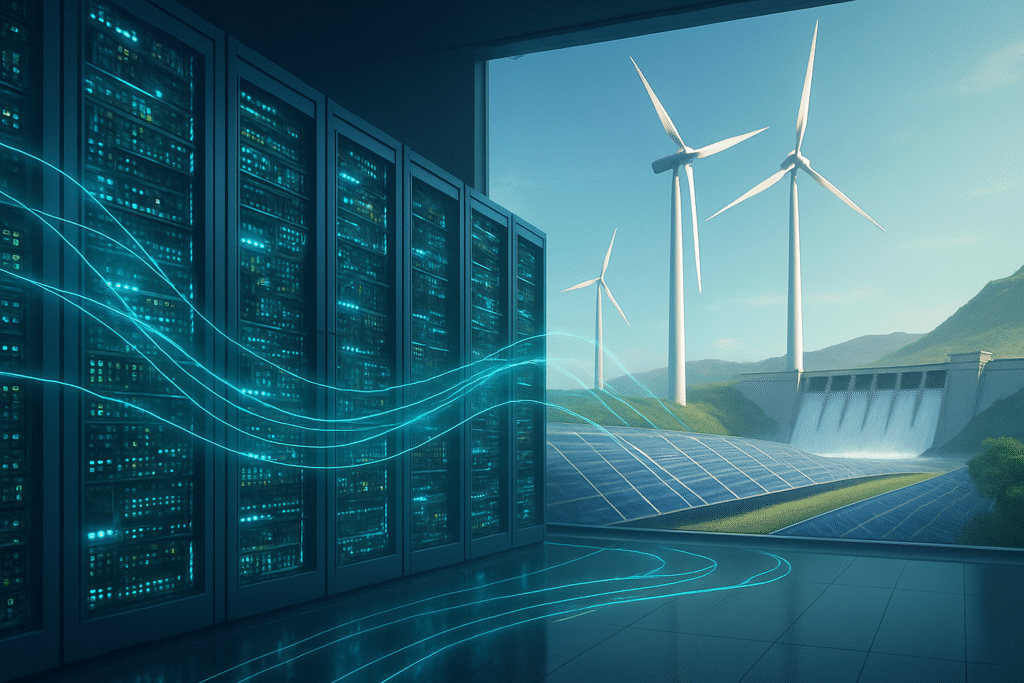
The insatiable demand for Artificial Intelligence (AI) is ushering in an unprecedented era of data center expansion, creating a monumental challenge for global energy grids and a powerful impetus for sustainable power solutions. As AI models grow in complexity and pervasiveness, their energy footprint is expanding exponentially, compelling tech giants and nations alike to seek out massive, reliable, and green energy sources. This escalating need is exemplified by the Democratic Republic of Congo (DRC) pitching its colossal Grand Inga hydro site as a power hub for AI, while industry leaders like ABB's CEO express profound confidence in the sector's future.
The global AI data center market, valued at $13.62 billion in 2024, is projected to skyrocket to approximately $165.73 billion by 2034, with a staggering 28.34% Compound Annual Growth Rate (CAGR). By 2030, an estimated 70% of global data center capacity is expected to be dedicated to AI. This explosion in demand, driven by generative AI and machine learning, is forcing a fundamental rethink of how the digital world is powered, placing sustainable energy at the forefront of technological advancement.
The Gigawatt Gambit: Unpacking AI's Energy Hunger and Hydro's Promise
The technical demands of AI are staggering. AI workloads are significantly more energy-intensive than traditional computing tasks; a single ChatGPT query, for instance, consumes 2.9 watt-hours of electricity, nearly ten times that of a typical Google search. Training large language models can consume hundreds of megawatt-hours, and individual AI training locations could demand up to 8 gigawatts (GW) by 2030. Rack power densities in AI data centers are soaring from 40-60 kW to potentially 250 kW, necessitating advanced cooling systems that themselves consume substantial energy and water. Globally, AI data centers could require an additional 10 GW of power capacity in 2025, projected to reach 327 GW by 2030.
Against this backdrop, the Democratic Republic of Congo's ambitious Grand Inga Dam project emerges as a potential game-changer. Envisioned as the world's largest hydroelectric facility, the full Grand Inga complex is projected to have an installed capacity ranging from 39,000 MW to 44,000 MW, potentially reaching 70 GW. Its annual energy output could be between 250 TWh and 370 TWh, an immense figure that could meet a significant portion of projected global AI data center demands. The project is promoted as a source of "green" hydropower, aligning perfectly with the industry's push for sustainable operations. However, challenges remain, including substantial funding requirements (estimated at $80-150 billion for the full complex), political instability, and the need for robust transmission infrastructure.
Meanwhile, industry giants like ABB (SIX: ABBN), a leading provider of electrical equipment and automation technologies, are expressing strong confidence in this burgeoning market. ABB's CEO, Morten Wierod, has affirmed the company's "very confident" outlook on future demand from data centers powering AI. This confidence is backed by ABB's Q3 2025 results, showing double-digit order growth in the data center segment. ABB is actively developing and offering a comprehensive suite of technologies for sustainable data center power, including high-efficiency Uninterruptible Power Supplies (UPS) like HiPerGuard and MegaFlex, advanced power distribution and protection systems, and solutions for integrating renewable energy and battery energy storage systems (BESS). Critically, ABB is collaborating with NVIDIA to develop advanced 800V DC power solutions to support 1-MW racks and multi-gigawatt AI campuses, aiming to reduce conversion losses and space requirements for higher-density, liquid-cooled AI infrastructure. This pioneering work on high-voltage DC architectures signifies a fundamental shift in how power will be delivered within next-generation AI data centers.
The AI Energy Arms Race: Strategic Imperatives for Tech Titans
The escalating demand for AI data centers and the imperative for sustainable energy are reshaping the competitive landscape for major AI companies, tech giants, and even nascent startups. Access to reliable, affordable, and green power is rapidly becoming a critical strategic asset, akin to data and talent.
Microsoft (NASDAQ: MSFT), for example, aims to power all its data centers with 100% renewable energy by 2025 and is investing approximately $80 billion in AI infrastructure in 2025 alone. They have secured over 13.5 gigawatts of renewable contracts and are exploring nuclear power. Google (NASDAQ: GOOGL) is committed to 24/7 carbon-free energy (CFE) on every grid where it operates by 2030, adopting a "power-first" strategy by co-locating new data centers with renewable energy projects and investing in nuclear energy. Amazon (NASDAQ: AMZN) (AWS) has also pledged 100% renewable energy by 2025, becoming the world's largest corporate purchaser of renewable energy and investing in energy-efficient data center designs and purpose-built AI chips.
Even OpenAI, despite its ambitious carbon neutrality goals, highlights the practical challenges, with CEO Sam Altman noting that powering AI in the short term will likely involve more natural gas, and the company reportedly installing off-grid gas turbines for its "Stargate" project. However, OpenAI is also exploring large-scale data center projects in regions with abundant renewable energy, such as Argentina's Patagonia.
Companies that successfully secure vast amounts of clean energy and develop highly efficient data centers will gain a significant competitive edge. Their ability to achieve 24/7 carbon-free operations will become a key differentiator for their cloud services and AI offerings. Early investments in advanced cooling (e.g., liquid cooling) and energy-efficient AI chips create a further advantage by reducing operational costs. For startups, while the immense capital investment in energy infrastructure can be a barrier, opportunities exist for those focused on energy-efficient AI models, AI-driven data center optimization, or co-locating with renewable energy plants.
The unprecedented energy demand, however, poses potential disruptions. Grid instability, energy price volatility, and increased regulatory scrutiny are looming concerns. Geopolitical implications arise from the competition for reliable and clean energy sources, potentially shaping trade relations and national security strategies. Securing long-term Power Purchase Agreements (PPAs) for renewable energy, investing in owned generation assets, and leveraging AI for internal energy optimization are becoming non-negotiable strategic imperatives for sustained growth and profitability in the AI era.
A New Energy Epoch: AI's Broader Global Footprint
The growing demand for AI data centers and the urgent push for sustainable energy solutions mark a profound inflection point in the broader AI landscape, impacting environmental sustainability, global economies, and geopolitical stability. This era signifies a "green dilemma": AI's immense potential to solve global challenges is inextricably linked to its substantial environmental footprint.
Environmentally, data centers already consume 1-2% of global electricity, a figure projected to rise dramatically. In the U.S., data centers consumed approximately 4.4% of the nation's total electricity in 2023, with projections ranging from 6.7% to 12% by 2028. Beyond electricity, AI data centers demand massive amounts of water for cooling, straining local resources, particularly in water-stressed regions. The manufacturing of AI hardware also contributes to resource depletion and e-waste. This resource intensity represents a significant departure from previous AI milestones; while AI compute has been growing exponentially for decades, the advent of large language models has dramatically intensified this trend, with training compute doubling roughly every six months since 2020.
Economically, meeting AI's surging compute demand could require an astounding $500 billion in annual spending on new data centers until 2030. Electricity is already the largest ongoing expense for data center operators. However, this challenge is also an economic opportunity, driving investment in renewable energy, creating jobs, and fostering innovation in energy efficiency. The economic pressure of high energy costs is leading to breakthroughs in more efficient hardware, optimized algorithms, and advanced cooling systems like liquid cooling, which can reduce power usage by up to 90% compared to air-based methods.
Geopolitically, the race for AI compute and clean energy is reshaping international relations. Countries with abundant and cheap power, especially renewable or nuclear energy, become attractive locations for data center development. Data centers are increasingly viewed as critical infrastructure, leading nations to build domestic capacity for data sovereignty and national security. The demand for critical minerals in AI hardware also raises concerns about global supply chain concentration. This shift underscores the critical need for coordinated efforts between tech companies, utilities, and policymakers to upgrade energy grids and foster a truly sustainable digital future.
The Horizon of Hyper-Efficiency: Future of AI Energy
The future of sustainable AI data centers will be characterized by a relentless pursuit of hyper-efficiency and deep integration with diverse energy ecosystems. In the near term (1-5 years), AI itself will become a crucial tool for optimizing data center operations, with algorithms performing real-time monitoring and adjustments of power consumption and cooling systems. Advanced cooling technologies, such as direct-to-chip and liquid immersion cooling, will become mainstream, significantly reducing energy and water usage. Waste heat reuse systems will capture and repurpose excess thermal energy for district heating or agriculture, contributing to a circular energy economy. Modular and prefabricated data centers, optimized for rapid deployment and renewable energy integration, will become more common.
Longer term (beyond 5 years), the vision extends to fundamental shifts in data center design and location. "Energy campus" models will emerge, situating AI data centers directly alongside massive renewable energy farms or even small modular nuclear reactors (SMRs), fostering self-contained energy ecosystems. Data centers may evolve from mere consumers to active contributors to the grid, leveraging large-scale battery storage and localized microgrids. Research into innovative cooling methods, such as two-phase cooling with phase-change materials and metal foam technology, promises even greater efficiency gains. Furthermore, AI will be used to accelerate and optimize chip design, leading to inherently more energy-efficient processors tailored specifically for AI workloads.
Experts predict a paradoxical future where AI is both a major driver of increased energy consumption and a powerful tool for achieving energy efficiency and broader sustainability goals across industries. The International Energy Agency (IEA) projects global electricity demand from data centers could surpass 1,000 TWh by 2030, with AI being the primary catalyst. However, AI-driven efficiencies in manufacturing, transportation, and smart grids are expected to save significant amounts of energy annually. An "energy breakthrough" or significant innovations in energy management and sourcing will be essential for AI's continued exponential growth. The emphasis will be on "designing for sustainability," reducing AI model sizes, and rethinking training approaches to conserve energy, ensuring that the AI revolution is both powerful and responsible.
Charting a Sustainable Course for AI's Future
The convergence of soaring AI demand and the urgent need for sustainable energy marks a defining moment in technological history. The key takeaway is clear: the future of AI is inextricably linked to the future of clean energy. The industry is undergoing a "ground-up transformation," moving rapidly towards a model where environmental stewardship is not merely a compliance issue but a fundamental driver of innovation, competitive advantage, and long-term viability.
The significance of this development cannot be overstated. It represents a critical shift from a phase of rapid, often unchecked technological expansion to one that demands accountability for resource consumption. The ability to secure vast, reliable, and green power sources will be the ultimate differentiator in the AI race, influencing which companies thrive and which regions become hubs for advanced computing. Initiatives like the Grand Inga Dam, despite their complexities, highlight the scale of ambition required to meet AI's energy demands sustainably. The confidence expressed by industry leaders like ABB underscores the tangible market opportunity in providing the necessary infrastructure for this green transition.
In the coming weeks and months, watch for continued massive investments in new AI data center capacity, particularly those explicitly tied to renewable energy projects or next-generation power sources like nuclear. Observe the proliferation of advanced cooling technologies and the deployment of AI-driven optimization solutions within data centers. Pay close attention to new regulatory frameworks and industry standards emerging globally, aiming to mandate greater transparency and efficiency. Finally, track breakthroughs in "Green AI" research, focusing on developing more computationally efficient models and algorithms that prioritize environmental impact from their inception. The journey towards a sustainable AI future is complex, but the path is now undeniably set.
This content is intended for informational purposes only and represents analysis of current AI developments.
TokenRing AI delivers enterprise-grade solutions for multi-agent AI workflow orchestration, AI-powered development tools, and seamless remote collaboration platforms.
For more information, visit https://www.tokenring.ai/.





